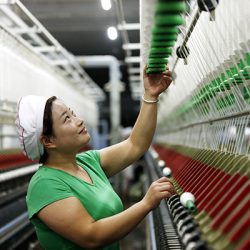Only as strong as the weakest link

Villagers living near Poyang Lake in China’s Jiangxi Province say the lake’s prawns are not even fit for pig feed. This is according to 2017 investigations by Changing Markets, an NGO, which highlighted how many of the world’s leading fashion brands source viscose (a material used in clothing) from factories that pollute the lake.
The charity’s report pointed the finger at a number of high profile brands, criticising them for sourcing materials from factories in the developing world, which dump toxic chemicals into the surrounding environment. Besides the negative press for these businesses, it also highlights the challenges these multinational firms face when it comes to managing their suppliers.
Indeed, some of these firms had already made commitments to making their sourcing more sustainable prior to the release of the Changing Markets report – showing that even firms with the best intentions struggle to ensure that suppliers conform to environmental, social and employment standards.
In a world where consumers are increasingly conscious of the environmental impact of their choices, some multinationals are attempting to clean up the way they procure materials from further up their supply chains. But, it is far from a straightforward undertaking.

Today’s consumers are increasingly environmentally conscious.
What is a sustainable supply chain?
Supply chains cross the globe, connecting people, businesses, finance and information, all of which goes into the creation of a final product. Making a supply chain sustainable involves major actors in a supply chain leveraging their power to ensure that their suppliers – and sometimes their customers – operate in ‘sustainable’ ways.
There are many ways of defining ‘sustainability’, but a good place to start is the UN Global Compact, a corporate social responsibility drive that many firms have signed up to. The compact requires businesses to meet “fundamental responsibilities in the areas of human rights, labour, environment and anti-corruption”.
A business might want to make its supply chain more sustainable for a range of reasons. Besides ethical concerns these firms may hold, there are also hard-nosed business reasons too. Dr Rosie Cole of The University of Surrey studies supply chains and explains that firms are increasingly aware of reputational risk from being seen to damage the environment. She also notes that there are risks of supply disruption – if a supplier was found to use child labourers, there could be major hold-ups as they try to find a replacement. NGOs and governments are also applying pressure.
What is more, there seems to be a shift in consumer expectations. One 2017 multi-country study by Unilever showed 33% choose to buy from brands they believe are doing “social or environmental good”, while a 2018 report by J. Walter Thomson Intelligence found 83% of consumers say they would pick brands with a strong record on sustainability.

33% choose to buy from brands they believe are doing social or environmental good.
Multinationals have a role to play
“These are global problems and global solutions are required” says Marta Iglesias, a senior consultant at The Carbon Trust, “and these multinationals have an important role to play because they are embedded in global networks”.
The Carbon Trust believes around 40% of an average multinational’s greenhouse gas emissions come from within its supply chain. If these firms are to seriously reduce their environmental impact, they will need to look not only at internal processes, but also at how their suppliers extract or produce raw materials, manufacture and distribute them – not to mention what happens after consumers have used them too.
This is far from easy. Ms Iglesias describes the challenges these firms have when it comes to transparency – there are often many tiers of suppliers who create components, which go into an end product, and it soon becomes difficult to find out who made what.
Dr Cole echoes this sentiment: “Take ‘ethical’ minerals. At the source, it is possible to monitor how precious gems are being extracted, but once you get ™凮
into the middle stages of processing, it all gets very murky”. Dr Cole explains how there are often many tiny businesses involved in the production of all sorts of goods – ensuring they are all compliant with the highest ethical standards is near impossible.
Case study: Nestlé’s Creating Shared Value initiative
Nestlé is among the world’s biggest food production companies, with supply chains that stretch across the globe. The Swiss business sources an enormous range of raw and processed materials, from palm oil to paper, sugar to cereal, coffee to cocoa, from every corner of the globe. Under its Creating Shared Value initiative, the company has committed to source those materials responsibly. While in some cases they buy direct from farmers, in other cases they buy through suppliers.
So, what is behind Nestlé’s strategy? A spokesperson for the company says: “Ensuring a sustainable supply chain contributes to fulfilling our company’s purpose. We do this across the value chain through the responsible sourcing of raw materials, packaging and the delivery of fresh products”.
How is this done? First and foremost, Nestlé requires all suppliers to adhere to its Responsible Sourcing Standard, which sets minimum levels for business practices. The spokesperson says: “The Standard sets out ways of working with regards to sourcing and production for our supply chain tiers, from Nestlé to suppliers, through intermediaries and all the way back to the origins of the goods and services we buy.”
Besides setting standards, there are also measures in place to ensure suppliers conform. Companies may be audited and asked to show how they’re complying with the standards: “If suppliers refuse to engage and no improvements have been made, Nestlé will remove these suppliers from its supply chains,” the spokesperson says. Losing such a big customer is, for many suppliers, a daunting prospect.
Where does the responsibility lie?
While many multinationals certainly seem to be making an effort to improve how they source goods, accusations of ‘greenwashing’ are never far away. The argument goes that some initiatives are little more than token gestures while the brands behind them don’t really change. Dr Cole points to a recent trend by a big sports brands to make limited runs of their trainers from repurposed ocean plastics: “The intention is fine, but if you look at the energy used in making those shoes, they’re hardly ‘green’.”
Nevertheless, it seems simplistic to place all the blame at the feet of big business. As Dr Cole notes: “It’s easy to blame multinationals, but until consumers actually start changing their behaviour and demanding, for example, shoes made from recycled plastic, things are unlikely to change.”
There are also undoubtedly examples of big firms using their sway to force suppliers to behave more responsibly. Ms Iglesias describes a couple of recent projects at The Carbon Trust, which saw Telefonica contractually oblige all its suppliers to conform to new emissions standards, and another where brewery Carlsberg began sourcing material for beer cans from more sustainable suppliers.
And these initiatives can have an effect. Nestlé’s 2018 Creating Shared Value report said that greenhouse gas emissions per tonne of products distributed are down 7.6% compared with 2014 – showing that these targets can have a real impact.
Chain of command
Inspect goods in a supermarket or shop and you’ll notice a huge array of labels testifying to the quality of the product’s supply chain – from fair trade to rainforest certified to various chemical and environmental standards such as ISO 14000. Some of these are mandatory while others are voluntary, making for a fairly confusing situation. “There are so many possible certifications that it’s confusing for both brands and consumers…these standards need to be consolidated,” says Dr Cole.
With the right intentions, it does seem possible for multinationals to have a real impact on environmental, employment and social conditions throughout their supply chains. Furthermore, consumers are increasingly demanding brands be more responsible – for Dr Cole, “that means there’s an economic incentive in meeting that demand, too”
For more supply chain insight and analysis, follow The European.


